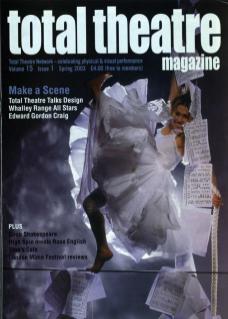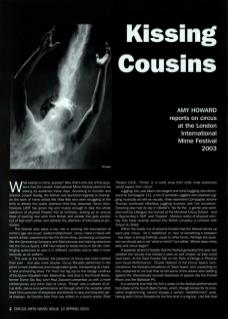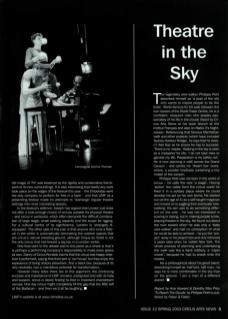What exactly is mime, anyway? Well, that's only one of the questions that the London International Mime Festival seems to be asking its audience these days. According to founder and director, Joseph Seelig, the festival was launched originally to champion the work of mime artists like Nola Rae who were struggling at the time to attract the public attention that they deserved. Since then, however, LIMF has grown big and muscly enough to take the whole spectrum of physical theatre into its embrace, serving up an annual feast of exciting new work from Britain and abroad that gets London out of bed each winter and attracts the attention of international producers.
The festival also plays a key role in pushing the boundaries of mime's age-old cousin (sister/mother/lover), circus. Hand in hand with recent artistic experiments like the Dome show, pioneering companies like the Generating Company and Mamaloucos and training resources like the Circus Space, LIMF has helped to boost circus in the UK, challenging audiences to view it in different contexts and to take it more seriously as an artform.
This year at the festival, the presence of circus was more marked than ever – and also more diverse. Circus Ronaldo performed in the genre's more traditional and recognisable guise, transporting its chaotic and enchanting show Fili from the big top to the foreign confines of the Queen Elizabeth Hall. Meanwhile, next door in the Purcell Room, former Dome Sky Boy John-Paul Zaccarini presented us with a more contemporary and ironic face of circus. Throat was a cabaret of circus skills, dance and performance art through which this versatile artist leapt from postures of desperate domesticity to sexy and beautiful aerial displays, As Dorothy Max Prior has written in a recent article (Total Theatre 14/3), Throat is 'a world away from what most audiences would expect from circus'.
Juggling, too, was taken into elegant and mind-boggling new dimensions by Compagnie 111, a trio of acrobatic jugglers who explored juggling musically as well as visually, while elsewhere Compagnie Jérôme Thomas combined effortless juggling routines with live accordion. Clowning also had its day in Okidok's Ha Ha Ha, a gentle and wordless work by a Belgian duo trained at the Montreal Circus School – and in Spymonkey's Stiff and Cooped, hilarious works of physical comedy that have recently earned this British company a contract with Cirque du Soleil.
Within the heady mix of physical theatre that the festival serves up each year, circus – be it ‘traditional' or 'new' or something in between – has taken a strong foothold, equal to other forms. Perhaps the question we should ask is not ‘what is mime?' but rather, 'Where does mime stop and circus begin?'
A separate strand of debate that the festival generated this year was whether the venues that hosted it were as well chosen as they could have been. At the Total Theatre Talk on the 'Role of Design in Physical and Visual Performance', Charlie Holland of the Circus Space commented on the festival's prevalence of ‘black boxes' and, expanding on this, explained to me that that he felt some of the shows were battling against the (theoretically neutral) blackness of spaces like the Purcell Room and the Barbican Pit.
It is certainly true that the lion's share of the festival performances took place at the South Bank Centre, which, though known for its innovative programming, cannot escape a certain 'establishment' aura. Having seen Circus Ronaldo for the first time in a big top, I did feel that the magic of Fili was lessened by the rigidity and conservative framework of its new surroundings. It is also interesting that hardly any work took place on the edges of the festival this year, the Chipolatas were the only company to perform for free in a foyer – and that LIMF as a presenting festival made no attempts to 'rearrange' regular theatre settings into more interesting spaces.
In the festival's defence, Joseph has argued that London just does not offer a wide enough choice of venues suitable for physical theatre – and circus in particular, which often demands the difficult combination of large stage, small seating capacity and the scope for rigging. For a cultural centre of its significance, London is ‘strangely ill-equipped'. The other side of this coin is that anyone who runs a festival in the winter is automatically eliminating the outdoor spaces that are circus' natural breeding ground, although Cirque du Soleil is not the only circus that has braved a big top in a London winter.
One final slant to the debate and to this piece as a whole is that it is perhaps a performing company's responsibility to make every space its own. Danny of Circus Ronaldo claims that the circus was happy wherever it performed, saying that their tent is ‘our house' but they enjoy the experience of being visitors elsewhere. And a black box, because of its very neutrality, has a marvellous potential for transformation.
However many sides there are to this argument, the continuing success and importance of LIMF remains undisputed and with its help and support, circus is slowly finding its feet in important mainstream venues. One day circus might completely fill the gap that the RSC left at the Barbican – and then we'd all be laughing.
LIMF's website is at www.mimefest.co.uk


